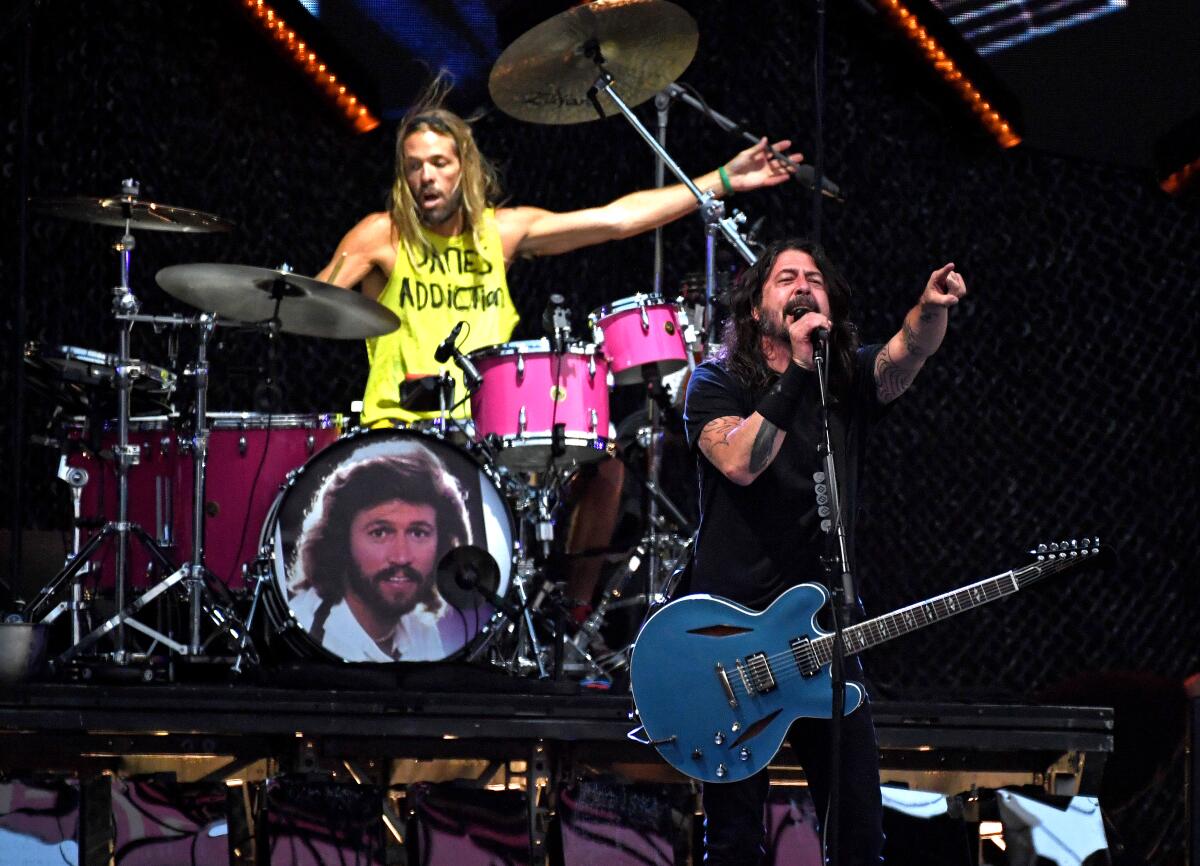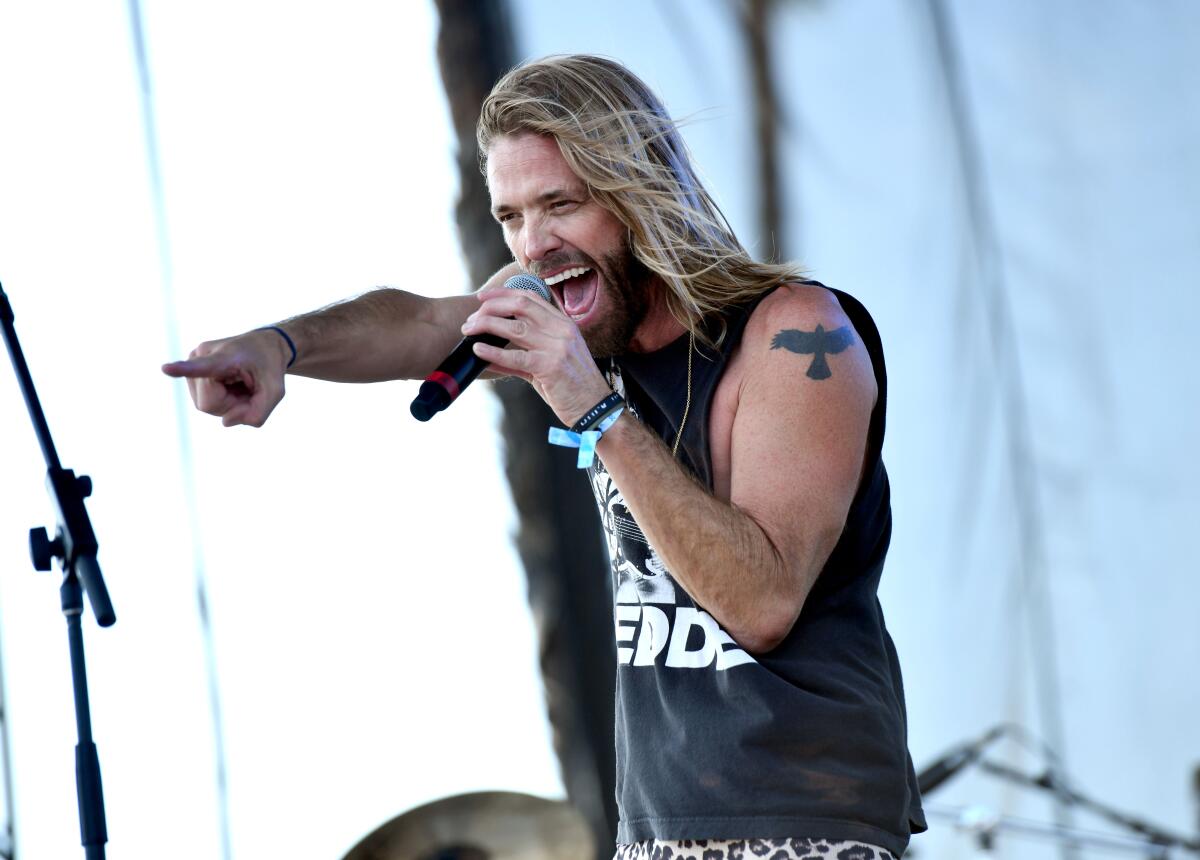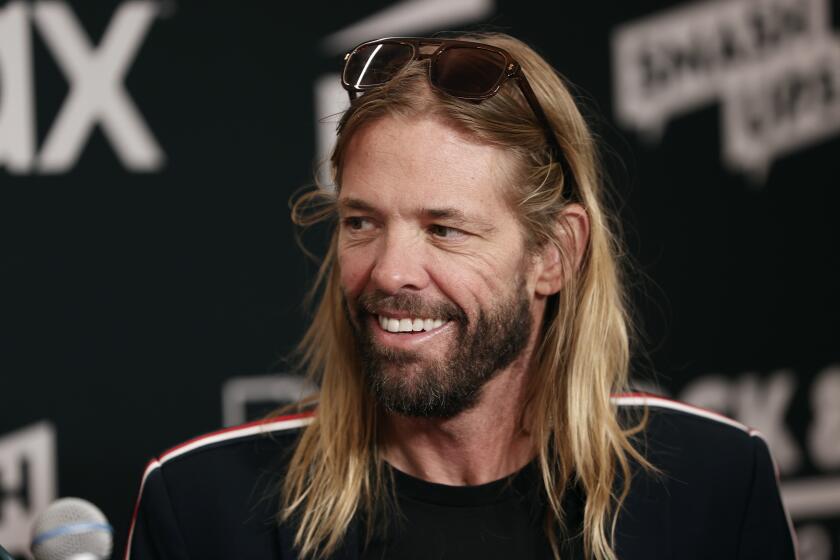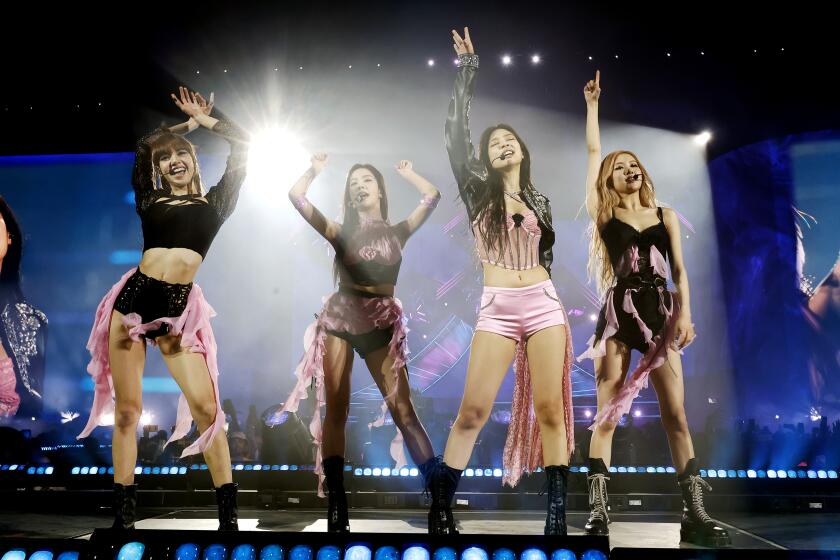Dave Grohl is the heart of Foo Fighters, but Taylor Hawkins was its rock star

- Share via
Taylor Hawkins may have been the only drummer alive who could have supported Dave Grohl in Foo Fighters and not make you wish Grohl was sitting behind the kit.
Hawkins — who died on Friday while on tour in South America, at age 50 — didn’t merely equal Grohl in terms of rhythmic thunder, he matched his bandmate’s cheerful disposition. Both musicians made it seem as if there was nothing better than being in a rock ’n’ roll band.
Taylor Hawkins, drummer for the rock band the Foo Fighters, died Friday in Bogota, Colombia.
Hawkins and Grohl had such an easy, natural camaraderie that they gave the impression that they were lifelong friends, a couple of pals who bashed out sloppy, spirited punk rock as high school classmates. This notion couldn’t be further from the truth.
Raised on opposite ends of the country — Hawkins’ family settled in Laguna Beach, Grohl called Virginia home — the pair took dramatically different paths to rock stardom. Grohl was a punk rocker drummer who wound up in Nirvana, a band that had a seismic influence on popular music in the early 1990s. Hawkins worked as a professional session musician, getting his first big break supporting Canadian blues-rocker Sass Jordan in the early 1990s. He leveraged that gig into a spot in Alanis Morissette’s touring band, joining the singer just prior to the release of her “Jagged Little Pill” album.
“Jagged Little Pill” turned into a pop phenomenon, so the irrepressible Hawkins soon was everywhere — MTV, sold-out concerts, industry events where he met such heavyweights as Grohl.
The pair became fast friends, but it took a while before they became collaborators. Originally designed as an outlet for his original songs, Foo Fighters became Grohl’s main gig after the death of Nirvana’s Kurt Cobain, but he had some difficulty transforming Foo Fighters into a flesh-and-blood rock band.
Foo Fighters had a smash out of the gate with Grohl’s one-man-band debut album in 1995, forcing him to quickly assemble a touring band. During the recording of their second album, 1997’s “The Colour and the Shape,” it became apparent that Grohl did not click with William Goldsmith, who joined Foo Fighters after Sunny Day Real Estate came to an end. After rerecording the drum parts, Grohl called Hawkins to pick his brain about potential drummers for the supporting tour. Hawkins volunteered himself.
Foo Fighters became a real rock band when Hawkins joined. In Hawkins, Grohl discovered a drummer who could not only play with a similar sense of fiery joy but also act as his foil. Blessed with the sun-bleached good looks of a beach bum, Hawkins exuded the charisma of a natural-born rock star, but there was nothing aloof about his public persona. He’d flash a wide smile when playing on stage, he’d ham it up on camera, don ridiculous costumes in music videos and encourage Grohl to embrace his silly side.
This levity acted as a necessary counterweight within Foo Fighters, who styled themselves as the heirs to old-fashioned arena rock. That instinct could lead the Foos down earnest musical paths that drifted toward the monochromatic — big guitars battling big drums and big hooks for sonic supremacy — but onstage, the grinning, bare-chested Hawkins gave their anthems a palpable sense of swagger and fun, along with a hint of sex appeal that was largely absent from the amiable Grohl.

Like Grohl, Hawkins was a drummer who harbored dreams of being a frontman. While he had the chance to front Foo Fighters on occasion — he sang a few lead vocals on record and recently had been given an onstage showcase where he belted Queen’s “Somebody to Love” — he indulged in these fantasies on his solo records. Cut with his ad hoc backing band the Coattail Riders — their very name a winking acknowledgment of his sideman status — his solo albums are odes to his beloved classic rock, bearing a notable trace of Cheap Trick’s power pop and a heavy debt to Queen’s pomp. These three records, the most recent of which was 2019’s “Get the Money,” didn’t get much exposure beyond hardcore Foo Fighters circles, but they’re perhaps the best distillation of how Hawkins radiated joy as he played music.
The explicit nods to classic rock on Hawkins’ solo albums started to seep into Foo Fighters, too, as the group began to play with different musical styles on later albums “Concrete and Gold” and “Medicine at Midnight,” both produced by Greg Kurstin. Here, the frivolity from Foo Fighters shows and music videos became tangible on record. They became so comfortable in their own skins they indulged in such charmingly ridiculous projects as releasing an EP of Bee Gees covers under the name the Dee Gees and starring in “Studio 666,” a horror film featuring the Foos as themselves.
When Grohl discovered Hawkins, he found not only his id, but also the musician who could allow him to fulfill his vision for Foo Fighters. With Hawkins at his side, Grohl turned Foo Fighters into the globe-conquering classic rock band he craved. Hawkins so fully embodied these rock star dreams that it’s now difficult to imagine Foo Fighters without him.
More to Read
The biggest entertainment stories
Get our big stories about Hollywood, film, television, music, arts, culture and more right in your inbox as soon as they publish.
You may occasionally receive promotional content from the Los Angeles Times.











